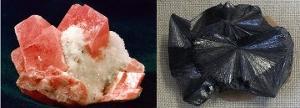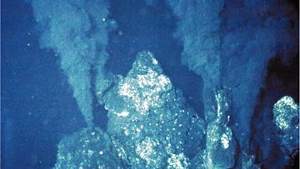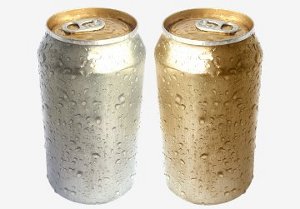The chemical element manganese is classed as a transition metal. It was first recognized as a distinct chemical element in 1740.

Data Zone
| Classification: | transition metal |
| Color: | gray-white |
| Atomic weight: | 54.9380 |
| State: | solid |
| Melting point: | 1250 oC, 1523 K |
| Boiling point: | 2060 oC, 2333 K |
| Electrons: | 25 |
| Protons: | 25 |
| Neutrons in most abundant isotope: | 30 |
| Electron shells: | 2,8,13,2 |
| Electron configuration: | [Ar] 3d5 4s2 |
| Density @ 20oC: | 7.43 g/cm3 |
Compounds, Radii, Conductivities
| Atomic volume: | 7.4 cm3/mol |
| Structure: | complex (cubic) |
| Hardness: | 6.0 mohs |
| Specific heat capacity | 0.48 J g-1 K-1 |
| Heat of fusion | 12.91 kJ mol-1 |
| Heat of atomization | 283 kJ mol-1 |
| Heat of vaporization | 219.74 kJ mol-1 |
| 1st ionization energy | 717.4 kJ mol-1 |
| 2nd ionization energy | 1509 kJ mol-1 |
| 3rd ionization energy | 3248.3 kJ mol-1 |
| Electron affinity | – |
| Minimum oxidation number | -3 |
| Min. common oxidation no. | 0 |
| Maximum oxidation number | 7 |
| Max. common oxidation no. | 2 |
| Electronegativity (Pauling Scale) | 1.55 |
| Polarizability volume | 9.4 Å3 |
| Reaction with air | mild, w/ht ⇒ Mn3O4, Mn3N2 |
| Reaction with 15 M HNO3 | mild, ⇒ Mn(NO3)2, NOx |
| Reaction with 6 M HCl | mild, ⇒ H2, MnCl2 |
| Reaction with 6 M NaOH | – |
| Oxide(s) | MnO, Mn3O4, Mn2O3, Mn2O7 |
| Hydride(s) | None |
| Chloride(s) | MnCl2 |
| Atomic radius | 140 pm |
| Ionic radius (1+ ion) | – |
| Ionic radius (2+ ion) | 89 pm |
| Ionic radius (3+ ion) | 75.3 pm |
| Ionic radius (1- ion) | – |
| Ionic radius (2- ion) | – |
| Ionic radius (3- ion) | – |
| Thermal conductivity | 7.81 W m-1 K-1 |
| Electrical conductivity | 0.5 x 106 S m-1 |
| Freezing/Melting point: | 1250 oC, 1523 K |

Manganese Ores: Rhodochrosite (manganese carbonate) on left: pink Mn2+. Pyrolusite (manganese dioxide) on right: black Mn4+.

Without manganese, this picture would not exist. In fact, there would be no advanced life forms on our planet. Manganese is essential for photosynthesis.

Manganese dioxide makes the black color in black smokers – hot geothermal vents on the ocean floor. Image courtesy: NASA.

Cave paintings, 16,000 years old, in Lascaux, France. The black color was made by our ancestors using manganese dioxide.
Discovery of Manganese
Manganese compounds have been used since ancient times.
In the first century AD, Pliny the Elder, the Roman author, described how black powder (manganese dioxide) was used to manufacture colorless glass. (1) It is still used for the same purpose today.
The first recognition of manganese’s existence as a distinct element was in 1740, when the German chemist Johann Heinrich Pott stated that pyrolusite (manganese dioxide) contained a new earth metal. Until then pyrolusite was believed to have been a compound of iron.
Pott prepared potassium manganate by fusing caustic potash (potassium hydroxide) with pyrolusite in air.
The color changes he observed in the product were green/blue/red/green, establishing that pyrolusite did not contain iron. (2),(2.1),(3)
Details of the first isolation of metallic manganese were published in 1770 by Ignatius Gottfried Kaim in a dissertation under the supervision of the chemist Jakab Jozsef Winterl.
Working in Vienna, Kaim mixed powdered pyrolusite with twice its weight of black flux and heated the mixture strongly. The composition of Kaim’s flux is uncertain, although it was probably based on charcoal. (A flux is a reducing agent.) If so, the reaction would have been:
MnO2 + C → Mn + CO2
Kaim described the product of the reaction as a blue-whitish shiny brittle metal with many differently shaped facets. When broken and viewed side-on, he observed blue flecks.
Kaim claimed that no iron was present in his product, but he was aware his manganese was not pure.
He invited other chemists to find a flux that could produce the pure metal. (4), (5)
In Sweden, Carl Wilhelm Scheele – the discoverer of chlorine and one of oxygen‘s independent discoverers – was aware that pyrolusite contained a new element. His attempts to isolate it failed and he asked his friend Johan Gottlieb Gahn to try.
Gahn used a similar method to the one Kaim had used a few years earlier, with charcoal as the reducing agent. Gahn used a blowpipe to increase the temperature of the reaction.
The metal he produced was white, hard and brittle; when broken it had a granular structure. Gahn’s manganese was also impure, but the new metallic element now gained widespread recognition. (2)
Manganese’s name comes from the use of its compounds in glass-making. These compounds were called ‘magnes’ in Latin, meaning ‘magnet.’ (6)
Manganese is not actually magnetic!
Interesting Facts about Manganese
- Manganese is an essential element in photosynthesis. Without it, there would be no free oxygen on earth.
- Human bodies contain a tiny amount of manganese: about 10 – 20 mg. If you chopped a 10c coin into 100 equal pieces, each piece would weigh more than the weight of manganese in an average human. Despite this, we cannot survive without it; manganese performs vital metabolic functions.
- Manganese in humans needs to be topped up frequently because our bodies cannot store it.
- Neanderthals may have used black manganese dioxide as a cosmetic 50 000 years ago. (7),(8)


Colors on opposite sides of the color wheel cancel.

Ever wondered how drink cans can be so thin? Manganese stiffens aluminum, so less of it is needed to make soft drink cans.
Appearance and Characteristics
Harmful effects:
Excess manganese, particularly inhalation of the powder/dust, is toxic. Exposure to manganese or manganese oxide(s) dust can result in a medical condition called manganism; symptoms resemble those of Parkinson’s disease. Workers at particular risk of exposure include miners and welders.
Characteristics:
Manganese is a gray-white, hard, brittle, metal that can take a high polish. It is not magnetic. The metal tarnishes on exposure to air and, when heated, oxidizes to manganese(II, III) oxide (Mn3O4).
Like other transition metals, manganese has more than one common oxidation state. The most stable is +2, which is a pale pink color in aqueous solutions. Also important is +4, brown/black, which is found in manganese dioxide; and +7 found in the purple permanganate anion MnO4–. Manganese’s +6 oxidation state is green.
Uses of Manganese
For over 2000 years manganese dioxide has been used to make colorless glass. Glass is made from sand (silica) and most sand contains iron (II) oxide, which naturally gives glass a green color. It is sometimes incorrectly stated that the manganese dioxide oxidizes the iron (II) oxide to iron (III) oxide; with a corresponding color change from intense green to pale yellow – and the pale yellow is too faint to be seen.
In fact, the real reason the glass decolorizes is complementary colors. Colors that are directly opposite one another on the color wheel (image: left) cancel one another out, to leave a pale gray.
In glass the manganese dioxide forms a violet silicate which cancels the green color of Iron (II). (9)
Manganese dioxide is also used as a black-brown pigment in paint and as a filler in dry cell batteries.
The great majority of manganese ore ends up in steel production where the manganese desulfurizes and deoxidizes the steel.
It is also is used extensively to produce a variety of important alloys. For example, the aluminum used to make most soft drinks cans contains about 1% manganese to improve the cans’ stiffness and corrosion resistance.
Organo-manganese compounds can be added to gasoline to increase its octane rating and reduce engine knock.
Manganese is the twelfth most abundant element in the earth’s crust and it is an essential trace element for all life on earth.
In the human body several manganese-containing enzymes are need to metabolize carbohydrates, cholesterol, and amino acids. Typically our bodies have about 10 – 20 mg manganese. This needs to be topped up frequently because our bodies cannot store it. About a quarter of the manganese in our bodies is in bone, while the rest is evenly distributed through our tissues. (10)
Abundance and Isotopes
Abundance earth’s crust: 0.1% by weight, 360 parts per million by moles
Abundance solar system: 10 parts per million by weight, 0.2 parts per million by moles
Cost, pure: $6.5 100g
Cost, bulk: $0.28 per 100g
Source: Manganese occurs mainly as the mineral pyrolusite (MnO2) and as rhodochrosite (MnCO3). Manganese can be found in manganese nodules on the ocean floor, but these are currently commercially unviable. Commercially, manganese is produced by reduction of its ores using aluminum. High purity manganese is made by electrolysis of manganese sulfate in solution.
Isotopes: Manganese has 21 isotopes whose half-lives are known, with mass numbers 46 to 66. Naturally occurring manganese consists of its one stable isotope, 55Mn.

References
- S. Venetskii, Metal from black stone., Metallurgist, 1 July 1966, Vol 10, Issue 7, p423-425.
- Mary Elvira Weeks, The discovery of the elements. III. Some eighteenth-century metals., J. Chem. Educ., 1932, 9 (1), p22. 2b. Mary Elvira Weeks, The discovery of the elements., 1960, Sixth Edition, p169-173, Journal of Chemical Education.
- Leopold Gmelin, Handbuch der Theoretischen Chemie., 1827, Vol. 1, Part 2, p882.
- Peter Joseph Macquers, Chymisches Wörterbuch oder Allgemeine Begriffe der Chymie nach Alphabetischer Ordnung, 1788, p572-573.
- J.C. Wiegleb, Geschichte des Wachsthums und der Erfindungen in der Chemie in der neuern Zeit, Zweyter Band von 1750 bis 1790., 1791, p104.
- Saul S. Hauben, The derivations of the names of the elements, J. Chem. Educ., 1933, 10 (4), p227.
- Winfried Henke, Thorolf Hardt, Handbook of Paleoanthropology, 2007, Volume 1, p1733, Springer.
- BBC Report, Neanderthal ‘make-up’ containers discovered 9 January 2010.
- David Dingledy, Decolorization of glass., J. Chem. Educ., 1965, 42 (3), p160.
- J. S. Garrow, W.P.T. James, A Ralph, Human nutrition and dietetics., 2000, p202, Churchill Livingstone.
Cite this Page
For online linking, please copy and paste one of the following:
<a href="https://www.chemicool.com/elements/manganese.html">Manganese</a>
or
<a href="https://www.chemicool.com/elements/manganese.html">Manganese Element Facts</a>
To cite this page in an academic document, please use the following MLA compliant citation:
"Manganese." Chemicool Periodic Table. Chemicool.com. 07 Oct. 2012. Web. <https://www.chemicool.com/elements/manganese.html>.
I really like the info on here it was helpful and useful! I had a report due on manganese due the next day and this site really saved my butt! thanks chemicool ;D
thx this is really helpful
I have an assignment due on Manganese due in three days, and I knew NOTHING about it at all!! This is a really good website, and it really helped it, I will be sure to tell all my friends, family and teachers about it!! You have put alot of thought into the information you have written here, Well Done 🙂
THANK YOU verry much this website helped me out a lot because im doing a school project on an element thank you
How to convert Manganese Carbonate to Mn3O4 commercially ?
This is a really great website i had a project on Manganese in Science class and this gave me so much info. Thanks Chemicoll